| 1 |
 |
“...there is a large bath in which
it is almost possible to swim. There is generally a
shower-bath also, and in British Guiana its use forms
the most popular style of bathing.
FOOD AND BEVERAGES. To visitors to the West
Indies fresh from temperate climes, both food and bever-
ages present decided features of novelty. Beef and
mutton find their places on the board, though, owing
to the climate, they are as a rule tough, except in
the larger islands in which supplies from the United
States are obtainable. Chicken and guinea-fowl figure
extensively on the menu, but otherwise a tropical table
differs materially from one at home. This is chiefly
the case with the fish and vegetables. Of the former
there are the flying-fish—'the dish par excellence of
Barbados, and very good it is too—snapper, snook,
mullet, and grouper, all of which are deservedly popular.
The cascadura, a fresh-water fish which is eaten in
Trinidad, is alleged to have properties not unlike those
possessed by the fountain of Trevi...”
|
|
| 2 |
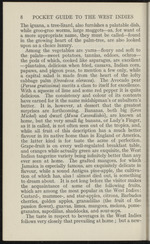 |
“...well-regulated breakfast table,
and oranges while actually green are exquisite, the West
Indian tangerine variety being infinitely better than any
ever seen at home. The grafted mangoes, for which
Jamaica is especially famous, are exquisitely delicate in
flavour, while a sound Antigua pine-apple, the cultiva-
tion of which has, alas ! almost died out, is something
to dream about. It is not long before the visitor makes
the acquaintance of some of the following fruits,
which are among the most popular in the West Indies:
Custard-, mammee-, and star-apples, citrons, Barbados
cherries, golden apples, granadillas (the fruit of the
passion flower), guavas, limes, mangoes, melons, pome-
granates, sapodillas, shaddocks, and sour-sops.
The taste in respect to beverages in the West Indies
follows very closely that prevailing at home ; but a new-...”
|
|
| 3 |
 |
“...for visitors to the West
Indies, and the opportunities for indulging in them are
dealt with under the heading “Sport” in the suc-
ceeding chapters. The favourite games are lawn-tennis,
croquet, golf, and cricket, and, in the islands under
American influence, baseball. There are ample faculties
for bathing and dancing, whilst in comparatively recent
years motoring has added greatly to the pleasures of a
visit to the tropics. Picnics, formerly called maroon
parties ” in the West Indies, are also popular. Fishing,
both in sea and river, and to a lesser extent shooting,
can also be enjoyed.
For filing the following tackle is recommended : Sea and
Estuary Tarpon rod ; 6-inch tuna reel; 300-yard, 21-thread
ocean line and spare hanks, 15-21 thread ; backing, leads, in-
cluding swivel leads, from 2 oz.; Punjab and piano wire, a good
supply, all sizes ; assorted hooks, single 3-8/0 ; treble, larger :
artificial baits assorted, chiefly 6-9-inch swallow tails, sand eels,
spoons, blue and silver, all...”
|
|
| 4 |
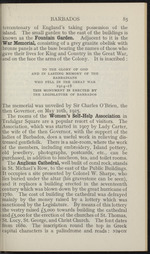 |
“...obelisk with
bronze panels at the base bearing the names of those who
gave their lives for King and Country in the Great War,
jand on the face the arms of the Colony. It is inscribed :
TO THE GLORY OF GOD
AND IN LASTING MEMORY OF THE
BARBADIANS
WHO FELL IN THE GREAT WAR '
1914-18
THIS MONUMENT IS ERECTED BY
THE LEGISLATURE OF BARBADOS
The memorial was unveiled by Sir Charles O’Brien, the
then Governor, on May 10th, 1925.
f The rooms of the Women’s Self-Help Association in
Trafalgar Square are a popular resort of visitors. The
[Association, which was started in 1907 by Lady Carter,
{the wife of the then Governor, with the support of the
ladies of Barbados, does a useful work in relieving dis-
itressed gentlefolk. There is a sale-room, where the work
of the members, including embroidery, Island pottery,
old jewellery, photographs, postcards, etc., can be
purchased,, in addition to luncheon, tea, and toilet rooms.
I The Anglican Cathedral, well built of coral rock, stands
in St. Michael’s Row...”
|
|
| 5 |
 |
“...pleasures these pure waters give,
But think of those which make the bathers live.
There is a fountain, Holy Scriptures say,
Where souls may bathe and sins be washed away.
Let all thy studies help thee Him to know
Through Whom for thee those heavenly waters flow.
The old estate’s bell, which used to summon the slaves
to work, in the garden behind the college should be
noted.
Bathsheba, St. Joseph (14 miles ; 1J hours by motor-
car, 2 hours by carriage, 19I miles by rail, froir
Bridgetown), a popular seaside resort, and Chalks
Mount, both on the Windward Coast, can be reached bj
the Barbados Railway. From Bathsheba the Potteries
on the top of the " Mount ” can be visited. They are
difficult to approach by carriage. Here the crude
though picturesque earthenware “ guglets,” “ monkeys/
and “ conerees,” as they are called according to thei:
shape, are fashioned by skilful black artificers at thei:
very primitive potter’s sheds. At Bathsheba it is prettj
to see the flying-fish fleet return after...”
|
|
| 6 |
 |
“...Anonima
di Navegafion fluvial y Costanesa de Venezuela, which proceed
every week to Ciudad Bolivar, whence smaller boats convey
such passengers as may desire to proceed farther, to the upper
reaches of the river. . 'v.
SPORTS. Lawn tennis is played on the courts of the
Tranquillity Club (near the Queen’s Park Hotel), and the St.
Clair Club, whose members are always glad to extend hospitality
to visitors suitably introduced. At the St. Clair Club bridge
and dancing can also be enjoyed. Cricket is popular. The
Queen’s Park Cricket Club, with a membership of over 400, has...”
|
|
| 7 |
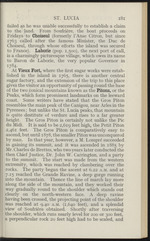 |
“...ST. LUCIA
181
failed as he was unable successfully to establish a claim
to the- land. From Soufrière, the boat proceeds on
Fridays1 to Choiseul (formerly 1’Anse Citron, but since
1763 called after the famous Minister, the Due de
Choiseul, through whose efforts the island was secured
to France). Laborie (pop. 1,500), the next port of call,
is a charmingly picturesque village, which owes its name
to Baron de Laborie, the very popular Governor in
‘1784.
At Vieux Fort, where the first sugar works were estab-
lished in the island in 1765, there is another central
sugar factory, and the extension of the trip to this place
gives the visitor an opportunity of passing round the base
of the two conical mountains known as the Pitons, or the
Peaks, which form prominent landmarks on the leeward
coast. Some writers have stated that the Gros Piton
resembles the main peak of the Canigou, near Arles in the
Pyrenees; but unlike the St. Lucia peaks, that mountain
is quite destitute of verdure and rises to...”
|
|
| 8 |
 |
“...194 POCKET GUIDE TO THE WEST INDIES
to hold 10,500 gallons of water. A splendid view of
Kingstown, the southern part of the island, and several
of the islets in the Grenadines, can be obtained from the
citadel.
Another popular ride or walk is to Dorsetshire Hill, on
which there used to be barracks for the troops, to the
north-east of Kingstown, and to the head of the Kings-
town waterworks below Mount St. Andrew, from which
the view is superb. The route lies along the lane running
past the west end of the cathedral. The reservoir,
1,500 feet above Kingstown, which is supplied from Mount
St. Andrew, has a capacity of 600,000 gallons.
Dorsetshire Hill was the scene of much fighting during
the wars with the French and the Caribs. The fortifica-
tions, which consisted only of earthworks, have long since
disappeared. To the north on Miller’s Ridge guns still
he dismounted on the ground.
An excellent school has recently been built on Dorset-
shire Hill to replace one destroyed by a hurricane...”
|
|
| 9 |
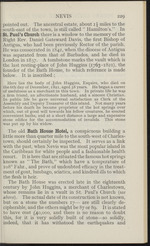 |
“...Not many years
before his death he became proprietor of the hot springs over
which, out of good will towards his fellow creatures, he erected
convenient baths, and at a short distance a large and expensive
stone edifice for the accommodation of invalids. This stone
was put up by his widow.
The old Bath House Hotel, a conspicuous building a
little more than quarter mile to the south-west of Charles-
town, should certainly be inspected. It serves as a link
with the past, when Nevis was the most popular island in
the Caribbean for white people and a fashionable health
resort. It is here that are situated the famous hot springs
known as “ The Bath,” which have a temperature of
1080 Fahr., and prove of undoubted efficacy in the treat-
ment of gout, lumbago, sciatica, and kindred ills to which
the flesh is heir.
The Bath House was erected late in the eighteenth
century by John Huggins, a merchant of Charlestown,
whose remains lie in a vault in St. Paul’s Church (see
above). The actual date of its...”
|
|
| 10 |
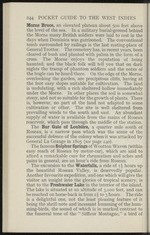 |
“...of Loubière, a quarter mile south of
Roseau, is a narrow pass which was the scene of the
successful defence of the colony when it was attacked by
General La Grange in 1805 (see page 240).
The famous Sulphur Springs of Wootton Waven (within
easy reach of Roseau by motor-car), which are said to
afford a remarkable cure for rhéumatism and aches and
pains in general, are an hour’s ride from Roseau.
The excursion to the Waterfalls, a ride of if hours up
the beautiful Roseau Valley, is deservedly popular.
Another favourite expedition, and one which will give the
visitor an insight into the glories of tropical scenery, is
that to the Freshwater Lake in the interior of the island.
The lake is situated at an altitude of 3,000 feet, and can
be reached on horse-back in from 2J to 3 hours. The ride
is a delightful one, not the least pleasing feature of it
being the shrill note and incessant humming of the hum-
ming-birds, the sound of which is in marked contrast to
the funereal tone of the “ Siffleur...”
|
|
| 11 |
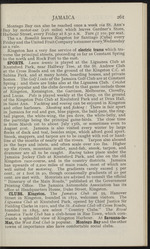 |
“...trains which tra-
verse the principal streets, proceeding as far as Constant Spring
to the north and Rock Fort to the east.
SPORTS. Lawn tennis is played at the Liguanea Club at
Knutsford Park, near Halfway Tree, at the St. Andrew Club
at the Cross Roads and on the ground of the Kingston C.C. at
I Sabina Park, and at many hotels, boarding houses, and private
homes. The Golf Links of the Jamaica Golf Club are at Constant
Spring.; and there are links also at the Liguanea Club. Cricket
. is very popular and the clubs devoted to that game include those
of Kingston, Kensington, the Garrison, Melbourne, Clovelly,
and Lucas. Polo is played weekly at the Camp, on the ground
of the Kingston Polo Club at Knutsford Park and at Drax Hall,
in Saint Ann. Yachting and rowing can be enjoyed in Kingston
and other harbours. Shooting and fishing : There is fair sport
in Jamaica for rod and gun, blue pigeon, the bald-pate, the ring-
tail pigeon, the white-wing, the pea dove, the white-belly, and
the partridge...”
|
|
| 12 |
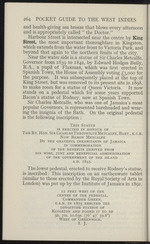 |
“...Sir Charles Metcalfe,
Governor from 1839 to *842, by Edward Hodges Baily,
R.A., a pupil of Flaxman, which was first erected in
Spanish Town, the House of Assembly voting .£3,000 for
the purpose. It was subsequently placed at the top of
King Street, but was removed to its present site in 1898,
to make room for a statue of Queen Victoria. It now
stands on a pedestal which for some years supported
Bacon’s statue of Rodney, now at Spanish Town.
Sir Charles Metcalfe, who was one of Jamaica’s most
popular Governors, is represented bareheaded and wear-
ing the insignia of the Bath. On the original pedestal
is the following inscription :
This Statue
IS ERECTED IN HONOUR OF
The Rt. Hon. Sir Charles Theophilus Metcalfe, Bart., k.c.b.
Now Baron Metcalfe
By the grateful inhabitants of Jamaica
IN COMMEMORATION
OF THE BENEFITS DERIVED FROM
HIS WISE, JUST AND BENEFICIAL ADMINISTRATION
OF THE GOVERNMENT OF THE ISLAND
A.D. 1845.
The lower pedestal, erected to receive Rodney’s statue,
is inscribed: This ...”
|
|
| 13 |
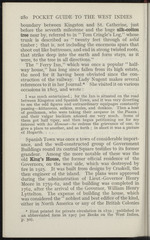 |
“...28o POCKET GUIDE TO THE WEST INDIES
boundary between Kingston and St. Catherine, just
before the seventh milestone and the huge silk-cotton
tree near by, referred to in “ Tom Cringle’s Log,” whose
trunk is described as twenty feet through of solid
timber; that is, not including the enormous spars that
shoot out like buttresses, and end in strong twisted roots, .
that strike deep into the earth and form stays, as it
were, to the tree in all directions.”
The " Ferry Inn,” which was once a popular " half-
way house,” has long since fallen from its high estate,
the need for it having been obviated since the con-
struction of the railway. Lady Nugent makes several
references to it in her Joumal. * She visited it on various
occasions in 1803, and wrote :
I was much entertained ; for the Inn is situated on the road
between Kingston and Spanish Town, and it was very diverting
to see the odd figures and extraordinary equipages constantly
passing—kittareens, sulkies, mules, and donkies. Then a host...”
|
|
| 14 |
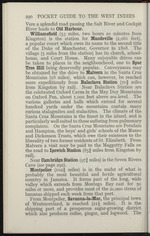 |
“...290 POCKET GUIDE TO THE WEST INDIES
Vere a splendid road passing the Salt River and Cockpit
River leads to Old Harbour.
Williamsfield (53' miles, two hours 20 minutes from
Kingston) is the station for Mandeville (2,061 feet),
a popular resort which owes its name to the second title
of the Duke of Manchester, Governor in 1808. The
village (5 miles from the station) has its church, school-
house, and Court House. Many enjoyable drives can
be taken to places in the neighbourhood, one to Spur
Tree Hill being deservedly popular. Conveyances may
be obtained for the drive to Malvern in the Santa Cruz
Mountains (28 miles), which can, however, be reached
more expeditiously from Balaclava Station (701 miles
from Kingston by rail). Near Balaclava Station are
the celebrated Oxford Caves in the May Day Mountains
on Oxford Pen, about 1,000 feet above sea-level. The
various galleries and halls which extend for several
hundred yards under the mountains contain many
curious stalagmites and stalactites....”
|
|
| 15 |
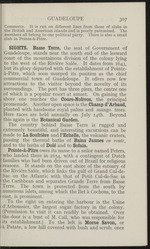 |
“...itre.
SIGHTS. Basse Terre, the seat of Government of
Guadeloupe, stands near the south end of the leeward
coast of the mountainous division of the colony lying
to the west of the Rivière Salée. It dates from 1643,
but its glory departed with the establishment of Pointe-
a-Pitre, which soon usurped its position as the chief
commercial town of Guadeloupe. It offers now few
attractions to the visitor beyond the novelty of its
surroundings. The port has three piers, the centre one
of which is a popular resort at sunset. On gaining the
shore one reaches the Cours-Nolivos, the principal
promenade.^ Another open space is the Champ d’Arbaud,
planted with handsome royal palms and mango trees.
Here races are held annually on July 14th. Beyond
this again is the Botanical Garden.
The country behind Basse Terre is rugged and
| extremely beautiful, and interesting excursions can be
; made to La Soufrière and 1’Echelle, the volcanic craters,
'.passing the thermal baths of Bains Jaunes en route,
and to...”
|
|
| 16 |
 |
“...to its summit, and harassed the French ships as they
passed to and from Fort Royal. (See page 182.)
“ H.M.S. Diamond Rock,” as it was called, is now
rarely visited except by fishermen ; but it is said that
the tomb of Lieutenant Robert Carthew Reynolds, who
was buried there, can still be seen.
That gallant officer died in September, 1805, of wounds
sustained seven months before, when cutting out the
French corvette Curieux which lay in the harbour of Fort
Royal. The funeral of this brave and popular officer...”
|
|
| 17 |
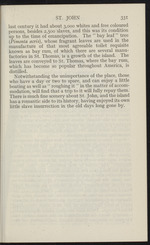 |
“...ST. JOHN 331
last century it had about 3,000 whites and free coloured
persons, besides 2,500 slaves, and this was its condition
up to the time of emancipation. The “ bay leaf ” tree
{Pimento. acris), whose fragrant leaves are used in the
manufacture of that most agreeable toilet requisite
known as bay rum, of which there are several manu-
factories in St. Thomas, is a growth of the island. The
leaves are conveyed to St. Thomas, where the bay rum,
which has become so popular throughout America, is
distilled.
Notwithstanding the unimportance of the place, those
who have a day or two to spare, and can enjoy a little
boating as well as “ roughing it ” in the matter of accom-
modation, will find that a trip to it will fully repay them.
There is much fine scenery about St. John, and the island
has a romantic side to its history, having enjoyed its own
little slave insurrection in the old days long gone by....”
|
|
| 18 |
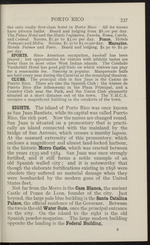 |
“...Hotels Inglaterra, Eureka, Roma, Caribe,
apd Central. Rooms, $1.50 to $3.00 per day. Ponce. Hotels
FranfaisaniMelia. Rooms, $1.50 to $5.00 per day. Mayagiiez.
Hotels Palmer and Paris. Board and lodging, $1.50 to $2.50
per day.
SPORTS. Since American occupation, baseball has been
played ; but opportunities for visitors with athletic tastes are
fewe.r than in most other West Indian islands. The Condado
Vanderbilt Hotel has good golflinks on which visitors can play
for a reasonable fee. Dancing is popular. Masquerade balls
are held every year during the Carnival at the municipal theatres.
CLUBS. The principal club in San Juan is the Casino de
Puerto Rico. There are also the Spanish Club ; the Ateneo de
Puerto Rico (the Athenaeum) in the Plaza Principal, and a
Country Club near the Park, and the Union Club pleasantly
situated at a short distance out of the town. The Y.M.C.A.
occupies a magnificent building in the outskirts of the town.
SIGHTS. The island of Porto Rico was once known
as San Juan...”
|
|
| 19 |
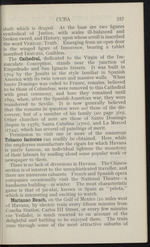 |
“...were not those of the dis-
coverer, but of a member of his family (see page 369).
1 Other churches of note are those of Santo Domingo
[.(begun in 1578), Santa Catalina (1700), and La Merced
(1744), which has several oil paintings of merit.
Permission to visit one or more of the numerous
Tobacco factories can readily be obtained. Here, while
I the employees manufacture the cigars for which Havana
I is justlv famous, an individual lightens the monotony
' of their labours by reading aloud some popular work or
newspaper to them.
There is no lack of diversions in Havana. The Chinese
section is of interest to the unsophisticated traveller, and
there are numerous cabarets. French and Spanish opera
companies occasionally visit the National Theatre a
handsome building—in winter. The most characteristic
game is that of jai-alai, known in Spain as “pelota,
which is interesting and exciting to watch.
Marianao Beach, on the Gulf of Mexico (10 miles west
of Havana by electric train every fifteen minutes...”
|
|
| 20 |
 |
“...butchery now going on. I do not think it
will be necessary for me to say what my procedure will be,
should my demands not receive attention .-^Lambton Loraine,
November 8th, 1873. *
Santiago is an extremely picturesque town with its
irregular streets of brightly coloured houses with red-
tiled roofs, its plazas, and its many trees. The best
shops are in Marina Street—which extends from the
Plaza to the bay—and San Tomas Street. Along the
bay is the Alameda, a charming drive-way, which is
deservedly popular.
One of the favourite expeditions from Santiago is to
the battlefields of San Juan and El Caney (4 miles),
which now comprise a public park. A simple column,...”
|
|
